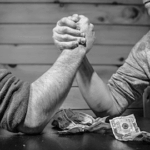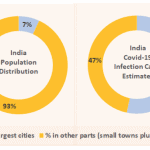Resolving the Core Tension of Impact-Focused Fintech: A Viable Model for Reaching Rural Women with Digital Financial Services
Before coming to IDEO.org, I worked in product management for Wave Money, one of Southeast Asia’s fastest-growing fintech companies. The company’s mission is to create a fairer future for Myanmar, and to that end, we made significant strides: By 2020 the company estimated that over 11% of the country’s GDP was being transferred via its mobile money accounts.
But as much as our mission centered on financial inclusion, we faced a core tension that all socially minded fintechs do: Reaching last-mile communities that have historically been excluded is hard for a business that also has to attend to its own bottom line. There are crucial market realities that make serving last-mile communities desirable from an impact perspective, but hard to prioritize from a business one.
Soon after I began working at IDEO.org, one of my first projects threw our product design team head-first into this tension. With support from the Bill and Melinda Gates Foundation, we partnered with BRAC (a prominent international nonprofit working to empower disadvantaged communities in Bangladesh), bKash (Bangladesh’s leading mobile wallet and a subsidiary of BRAC Bank), and the Busara Center for Behavioral Economics to increase access to digital financial services (DFS) for women living in the Haor region of Bangladesh, by assisting them in downloading and using the bKash app. As the business designer on the team, I knew we’d have to build a viable business case for targeting these rural women in order for IDEO.org’s co-created designs to succeed.
Throughout the project, I kept putting myself in the shoes of my former manager at Wave Money, and asked myself what it might take to prioritize reaching rural women, despite the pressure of aggressive financial targets our team had to consistently meet. To better understand that pressure and why market realities make it hard to invest in rural outreach targeting women, let’s explore a few of the negative feedback loops at play in many emerging markets.
The challenge of building a business case for serving rural women
Why is building a viable business case for rural women so tricky? Let’s start by taking a closer look at the potential users of digital financial services – in this case, women living in rural areas of Bangladesh. Different levels of digital and financial literacy among these customers can make the experience of conducting a financial transaction on a mobile device confusing and risky. After all, one wrong click or swipe could mean money lost forever.
According to 2017 Findex data, men are twice as likely as women to have access to both a mobile phone and internet in Bangladesh. Because women living in rural areas of the country haven’t historically been the primary operators of their own mobile devices, making them comfortable using a phone to transact requires more time and energy than introducing the bKash app to an urban digital native who is already familiar with online games and social media. So from the perspective of the financial service provider, women living in rural Bangladesh are more costly to acquire as customers.
Furthermore, while IDEO.org’s research shows that women do a significant portion of the household saving in Bangladesh and other emerging markets, their financial activities and knowledge are not typically acknowledged by family members or the formal financial sector, and the broader society views finance as the domain of men. In Bangladesh, because women have been traditionally excluded from formal finance, their ability to make transactions via a digital financial services app is generally lower than that of men – and rural women’s ability to navigate these apps is generally lower than their urban counterparts. For the financial service provider, this means that once rural women are acquired as customers, they are not expected to transact often or in large amounts.
Our approach for tackling this challenge
Our starting point for this project was immersive design research that helped us identify an opportunity to build onramps to digital finance that would let women learn, and even play, while building their confidence to complete digital transactions. While there’s a lot to be said for in-app tutorials, which provide digital handholding for new users, we saw a need in this scenario to create physical spaces that normalize women’s use of their phones to make financial transactions.
For bKash, creating and operating these spaces in rural Bangladesh would require a major investment, and the development of new organizational capabilities. That’s why we were fortunate that this partnership involved BRAC, an NGO that already had the rural presence and community credibility to convene women, and a vested interest in building financial confidence among them. Through this partnership, we hoped to build a service that would both address the needs of women, and unlock business viability in the process. So, in collaboration with BRAC’s Social Innovation Lab team and bKash, we created BRAC Shakti.
The BRAC Shakti Model
BRAC Shakti is a digital savings group through which rural women in Bangladesh form “pods” of five or six members, who collectively agree on a weekly savings goal and meet each week to contribute money towards that goal, and to learn about navigating household finances and using digital financial services. During the gatherings, an “Appa” (or big sister) works in partnership with a BRAC field officer to facilitate role plays, trainings and Q&A sessions, all intended to familiarize women with transacting digitally – in this case using the bKash app.
At the end of each gathering, women have the option of visiting a nearby agent shop to deposit money into their digital savings accounts. For every week that women deposit, they earn rewards of increasing value. Instead of rewarding a one-off deposit, we wanted to incentivize the building of a savings habit, by offering women bigger rewards if they deposit multiple times at regular intervals.
At the end of the eight-week program, groups that meet their overall savings goals unlock a significant reward, such as inputs or training they can use to set up a household livestock business.
Breaking negative feedback cycles and unlocking viability in a rural market
BRAC Shakti breaks down barriers in digital and financial literacy by creating safe, peer-mediated spaces where women can come together to learn and practice. Furthermore, in the design of BRAC Shakti’s incentives, our team offered 100 taka (roughly US $1.15) to any user who downloaded the bKash app and cashed into their new account. We used 100 taka intentionally as our benchmark for the value of these savings rewards, since at the time, bKash was already offering this amount in rewards to all new customers. Our goal was to show that acquiring rural women could be no more costly to bKash than acquiring users through its existing channels. The BRAC Shakti program conducted an initial pilot in 2020, and BRAC is currently conducting a larger pilot with more than 5,000 women, aiming (in part) to iterate on the value and form of these rewards.
Based on these pilots, it has become clear that people who begin to use bKash through the BRAC Shakti program are more valuable customers than people who randomly download the bKash app and may or may not use it. By the time they complete the “BRAC Shakti Challenge,” in which an entire savings group unlocks rewards at the end of the program if all its members reach their saving goals, participants have repeatedly deposited funds into their accounts, and have developed a high degree of familiarity with the app. They are positioned to be long-term users of bKash. Throughout the ongoing pilot, the BRAC team will monitor how completion of BRAC Shakti impacts long-term use of bKash’s mobile money products.
A promising early start for BRAC Shakti
One of the challenges social enterprises face is that, while driven by social missions, they’re ultimately accountable to market forces that historically have made it financially difficult to reach the most marginalized customers. With BRAC Shakti, the partnership between a DFS provider (bKash) and an NGO that has an existing rural presence (BRAC) has managed to break down the fundamental financial barriers currently preventing DFS providers from investing in rural women. In so doing, both parties benefit: bKash competitively acquires a loyal customer base in rural women, and BRAC achieves its mandate of reaching historically underserved populations – while also building a user base that can later participate in its own microfinance offerings.
We embarked on this design journey with two organizations that agreed to prototype the BRAC Shakti Challenge approach together during a five-month period in 2020. Now, during the expanded pilot stage, BRAC is holding the reins and iterating on the BRAC Shakti model as it is put into practice by 5,000 women. Our hope is that this work will inspire other DFS providers and organizations with rural reach to explore partnerships that enable the sector to sustainably reach and empower communities at the margins.
When I look back on the conversations I used to have with my former manager at Wave Money, I realize that the challenges they – and countless companies like them – have faced in profitably serving last-mile communities are solvable. I’ve come to see that partnerships are a big part of the solution – but I’ve learned that there are three key questions that must be asked of any potential partnership that aims to subvert the market realities that make reaching the last mile so difficult:
- Does one of the partners have a social, non-market driven mandate to reach the last mile? One of the key reasons why the partnership between BRAC and bKash is so beneficial is because BRAC already has a mandate to promote the financial inclusion of women.
- Does one of the partners have rural reach, credibility and convening power? Establishing these on your own is costly and time-consuming.
- Can we show that users are dramatically more engaged with a fintech tool in the long term as a result of the program? If so, then there is a case for financial investment and for potential cost sharing among partners.
By exploring mutually beneficial partnerships – and ensuring that the interests of both sides are aligned from the start – DFS providers and NGOs can generate essential synergies that can unlock both profit and social impact, while bringing beneficial products to the world’s most excluded communities. To that end, we believe the momentum we’ve generated with the BRAC Shakti program can provide other businesses and organizations with a promising model.
Claudia Sosa Lazo is a Business Design Lead at IDEO.org.
Photo courtesy of UNSGSA/Ismael Ferdous.
- Categories
- Finance, Technology



